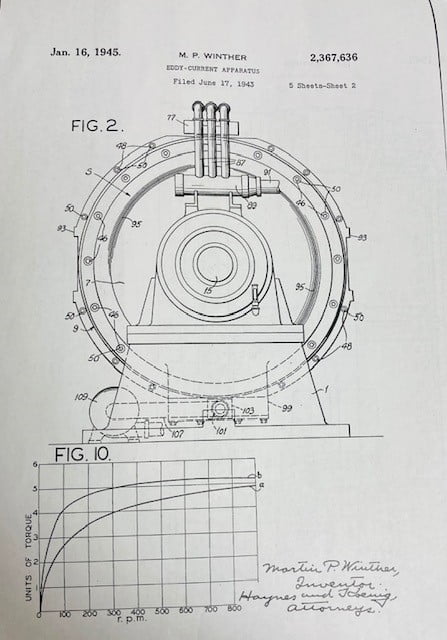The year was 1943. Martin P. Winther filed a patent with the United States Patent Office for an “Eddy-Current Apparatus” that would eventually launch what is now the Dynamatic brand. On that date in June, it was filed specifically for dynamometers – equipment used to measure torque and rotational speed of a motor or engine. The patent was filed as an improvement on other constructions from Charles T. Hayes and Ernest Bernard, who filed patents for “electromagnetic apparatuses.”
Engineering Improvements
The patent was filed because Winther noticed a problem with the existing mechanical devices. With his entrepreneurial mindset and engineering prowess, he decided to fix it. The problem: water cooling the flux gap of an electrical dynamometer in real applications caused some dynamometers to “surge or stutter,” which made it very difficult to maintain a steady balance on the dynamometer weight scales, and readings on the scales became difficult to obtain accurately.
His invention, the eddy current apparatus, produced a high-capacity machine which operated very smoothly so that steady readings could be recorded, particularly with high torque.
The patent was finally approved in January 1945, which makes it as old as old as Social Security checks, M&M candies, and Chuck Norris, and it described the construction of his eddy current apparatus in detail. In essence, water is supplied to the space between the stator and outside of the rotor from pipes through soft, rubber hoses. He described a bank of parallel hoses, which provided flexibility to the design. This water-cooled design operated as follows, according to the filed patent:
How It Works
“The coils are energized with direct current from a suitable source, thus engendering toric flux fields around the respective coils… The current adjacent coils flows in opposite peripheral directions, so that bucking action between the magnetic circuits between coils is avoided. Flux concentrations emanate from a band of teeth of north polarity, loop through the adjacent drum thus closing magnetic circuits around the coils. Since the drums rotate, being driven from the prime-mover shaft, heating eddy currents are engendered in the drums. Water flows through the passages, pipes, and into the stator through the openings. This places it between the drums and the stator.”
Within the drums is a splash system of cooling, which uses very little water against the drum and the water flows at a constant speed, and which eliminates drag. The drum temperature only becomes a few degrees higher than the water discharge to avoid high-fiber stresses in the metal. Winther’s patent also included some new safety features to the design, particularly for high-capacity machines.
Drives, Brakes, Couplings and More
According to the Wisconsin Historical Society, the Winther brothers were “granted patents for almost 300 car and truck-related mechanical devices. These included the first successful air conditioning system for Pullman railroad cars, a builder’s hoist, a four-wheel-drive post hole digger for AT&T, the first induction coupling, a magnetic clutch, a cycle-car, variable-speed transmission gears, an isomeric pole magnet, as well as a giant press drive, brakes and couplings for the oil field industry. Martin and (his brother) Anthony also invented and manufactured a new type of high speed, high-power dynamometer capable of far surpassing those currently in production, which could not turn fast enough for the new turbine engines used in aircraft, wind tunnels and high-speed automobiles.”
As we celebrate that which put Dynamatic on the map as a brand, we continue to lead the way in variable speed eddy current drives, brakes, clutches and controls. We celebrate the patent that led to our magnetic clutches and couplings, and we are excited that customers such as NASA, Boeing, John Deere, Volvo, Ford Motor Company and large municipal water and wastewater treatment plants have chosen to use this technology not only for its ruggedness and longevity, but also for its efficiency.
Winther may not have seen 76 years into the future beyond his patent, and his inventions surely changed into higher technology, but he certainly expected this patent to change the automotive industry as he knew it. We like to think that he’s still celebrating his success as we come into our 90th year as a company and continue using the invention he patented in 1945.

